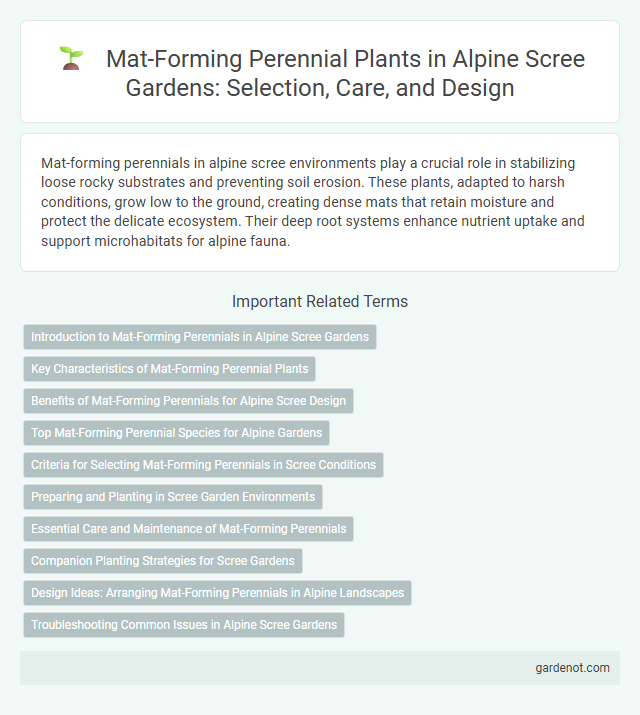Mat-forming perennials in alpine scree environments play a crucial role in stabilizing loose rocky substrates and preventing soil erosion. These plants, adapted to harsh conditions, grow low to the ground, creating dense mats that retain moisture and protect the delicate ecosystem. Their deep root systems enhance nutrient uptake and support microhabitats for alpine fauna.
Introduction to Mat-Forming Perennials in Alpine Scree Gardens
Mat-forming perennials in alpine scree gardens create dense, low-growing carpets that stabilize loose rocky soils and reduce erosion. Species such as Saxifraga, Silene, and Phlox thrive in well-drained, nutrient-poor scree environments, displaying adaptations like deep root systems and drought resistance. These plants enhance biodiversity by providing shelter and microhabitats, while their flowering cycles contribute to seasonal color variations in rugged mountain landscapes.
Key Characteristics of Mat-Forming Perennial Plants
Mat-forming perennial plants exhibit dense, low-growing growth patterns that stabilize alpine scree by preventing soil erosion and retaining moisture. Their extensive root systems create interwoven mats that protect against harsh winds and temperature fluctuations typical of mountainous environments. These plants often feature tough, leathery leaves and deep roots to survive nutrient-poor, rocky soils and extreme alpine conditions.
Benefits of Mat-Forming Perennials for Alpine Scree Design
Mat-forming perennials stabilize Alpine scree by creating dense ground cover that reduces soil erosion and moisture loss. Their low growth habit maximizes exposure to sunlight while protecting the substrate from harsh winds and temperature fluctuations. These plants enhance biodiversity by providing habitat and food sources for alpine insects and small wildlife.
Top Mat-Forming Perennial Species for Alpine Gardens
Silene acaulis is a top mat-forming perennial species prized in alpine gardens for its dense, cushion-like growth and vibrant pink to purple flowers. Dryas octopetala thrives in rocky, well-drained soils, offering evergreen foliage and white blossoms that enhance alpine scree aesthetics. Saxifraga oppositifolia provides exceptional ground cover with its deep purple blooms and adaptability to harsh mountainous conditions.
Criteria for Selecting Mat-Forming Perennials in Scree Conditions
Mat-forming perennials in alpine scree must exhibit exceptional drought tolerance and the ability to thrive in nutrient-poor, well-drained substrates typical of scree environments. Species such as Sedum and Saxifraga are favored for their low growth habit, resilience to temperature fluctuations, and root systems adapted to anchor in unstable rocky terrain. Selection criteria prioritize hardiness in extreme conditions, low water requirements, and capacity for rapid ground coverage to stabilize scree slopes and prevent erosion.
Preparing and Planting in Scree Garden Environments
Mat-forming perennials thrive in scree garden environments by establishing strong root systems that stabilize loose stones and optimize water retention. Preparing the scree bed involves ensuring excellent drainage and incorporating gritty, well-draining soil amendments to mimic alpine conditions. Planting should be scheduled during early spring or autumn to allow roots to establish before extreme temperatures, enhancing survival rates in harsh, rocky terrains.
Essential Care and Maintenance of Mat-Forming Perennials
Mat-forming perennials thrive in well-drained, rocky soils typical of alpine scree environments, requiring minimal watering once established to prevent root rot. Essential care involves pruning to maintain their low, spreading habit and removing dead foliage to encourage healthy growth and enhance air circulation. Applying a thin mulch layer in colder climates protects roots from frost, while avoiding excessive fertilization to preserve their natural resilient adaptations.
Companion Planting Strategies for Scree Gardens
Mat-forming perennials such as Saxifraga and Phlox are ideal for scree gardens due to their low-growing, spreading habit that stabilizes rocky soils. Incorporating cushion-forming plants like Dianthus and Sedum creates a microhabitat that retains moisture and reduces erosion in alpine scree environments. Strategic companion planting enhances biodiversity and resilience, promoting healthy root networks and improving overall garden aesthetics.
Design Ideas: Arranging Mat-Forming Perennials in Alpine Landscapes
Mat-forming perennials in alpine scree gardens create low-growing, textured carpets that stabilize rocky soil and enhance visual appeal with dense, compact foliage. Incorporating species such as Silene acaulis, Sedum spp., and Alyssum montanum in grouped designs accentuates natural contours while maximizing ground cover in harsh, well-drained conditions. Strategic placement near rock crevices fosters moisture retention and mimics native alpine habitats, promoting plant health and ecosystem harmony.
Troubleshooting Common Issues in Alpine Scree Gardens
Mat-forming perennials in alpine scree gardens often struggle with drainage problems, causing root rot and fungal diseases that stunt growth. Ensuring well-drained soil composed of coarse grit, sand, and minimal organic matter is critical to prevent moisture retention. Regularly inspecting plants for signs of mold or yellowing leaves allows early intervention through improved airflow and removal of affected tissues.
Mat-forming perennial Infographic

 gardenot.com
gardenot.com